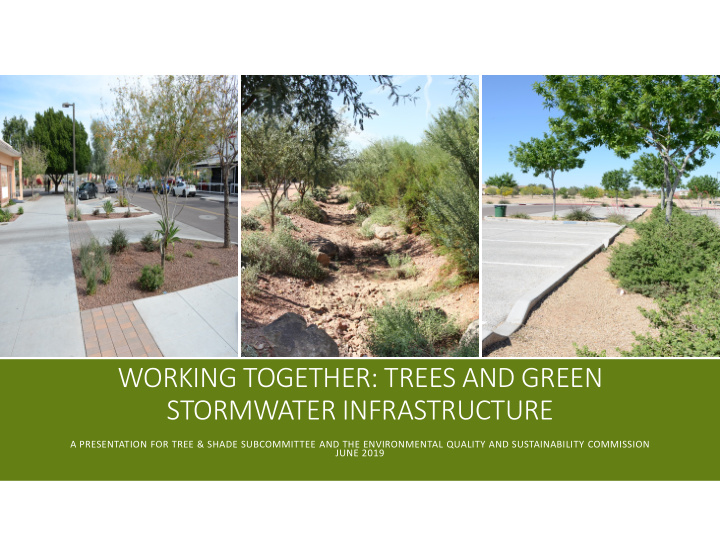



WORKING TOGETHER: TREES AND GREEN STORMWATER INFRASTRUCTURE A PRESENTATION FOR TREE & SHADE SUBCOMMITTEE AND THE ENVIRONMENTAL QUALITY AND SUSTAINABILITY COMMISSION JUNE 2019
WHAT IS GREEN INFRASTRUCTURE/LOW IMPACT DEVELOPMENT (GI/LID)? Courtesy of Mass.gov Smart Growth, Smart Energy Toolkit Water management approach that protects, restores, or mimics the natural water cycle • Manages stormwater where it falls • Landscape-based practice to help maintain pre-development hydrological conditions
GI/LID EXAMPLES Primera Iglesia Curb cut Bioretention 36 th Street and Rosemonte Dr. Permeable Pavers Bioswale Fire Training Academy
Urban Heat Island Stormwater Runoff Local Flooding Air Quality Biking/Walking Environment Water Conservation
2018 PHOENIX GI/LID TBL COST-BENEFIT ANALYSIS 1,000 sqft feature type analysis, City of Phoenix (Absolute)
2018 PHOENIX GI/LID TBL COST-BENEFIT ANALYSIS 1,000 sqft feature type analysis, City of Phoenix (Relative to Concrete)
CIVIC SPACE EXAMPLE – POROUS CONCRETE
PRIMERA IGLESIA EXAMPLE Bioretention Basin with Curb Cuts • Plant selection • Supplemental irrigation for establishment • No long-term irrigation
RIGHT GI/LID, RIGHT PLACE
KEY GI/LID TBL COST-BENEFIT STUDY RECOMMENDATION ▪ Tree and Shade Masterplan ▪ Integrate GI/LID to reduce potable water use in native landscapes Full TBL CBA at www.phoenix.gov, Departments, Environmental Programs https://www.phoenix.gov/oepsite/Documents/City%20of %20Phoenix_GI%20and%20LID_TBL- CBA%20Autocase%20Features%20and%20Projects%20Ev aluation_06-21-2018.pdf
HANDBOOK CONTENTS Methodology Provides technical standard details and specs for 10 LID features in (MAG) format 1. Permeable pavement 2. Curb openings 3. Curb openings 4. Sediment traps 5. Stormwater harvesting basins 6. Vegetated or rock bioswales 7. Bioretention systems 8. Curb extensions 9. Bioretention planters 10. Domed overflow structures The handbook also contains • Landscape details and specifications • Additional resources https://www.phoenix.gov/oepsite/Documents/SCN%20GI%20 Handbook_January%202019.pdf
GI/LID AND TALL POTS – A WIN FOR WATER CONSERVATION AND SHADE What are tall pots? • Grown in a long container (various sizes) • 30” long; 6” diameter Why it works • Most desert species have long taproots • Tall pots mimic these growth characteristics of native desert trees • Higher ‘root to shoot’ ratio helps survivability
TALL POT GROWTH FCDMC Durango Complex - 2007 Benefits Don’t require supplemental water • • Good survival rates • Cost-effective FCDMC Durango Complex - 2015
WORKING TOGETHER: TREES AND GI/LID A WINNING COMBO QUESTIONS?
Recommend
More recommend